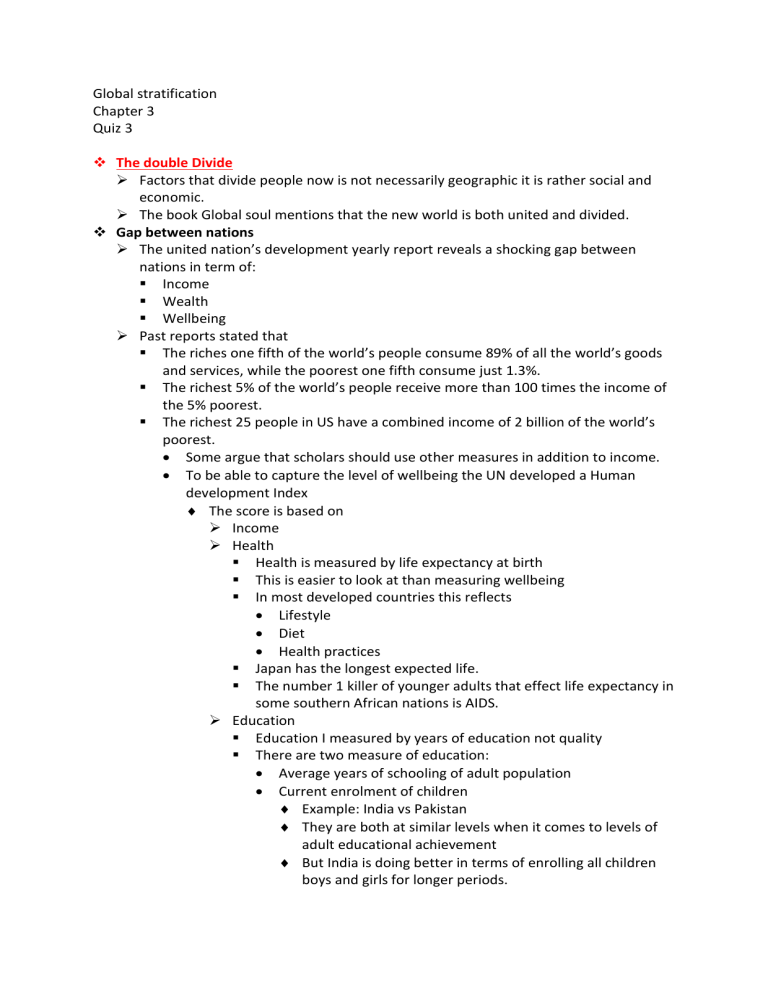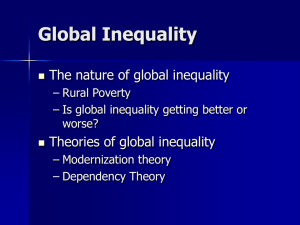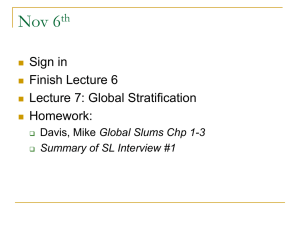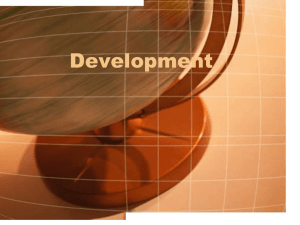
Global stratification Chapter 3 Quiz 3 The double Divide Factors that divide people now is not necessarily geographic it is rather social and economic. The book Global soul mentions that the new world is both united and divided. Gap between nations The united nation’s development yearly report reveals a shocking gap between nations in term of: Income Wealth Wellbeing Past reports stated that The riches one fifth of the world’s people consume 89% of all the world’s goods and services, while the poorest one fifth consume just 1.3%. The richest 5% of the world’s people receive more than 100 times the income of the 5% poorest. The richest 25 people in US have a combined income of 2 billion of the world’s poorest. Some argue that scholars should use other measures in addition to income. To be able to capture the level of wellbeing the UN developed a Human development Index The score is based on Income Health Health is measured by life expectancy at birth This is easier to look at than measuring wellbeing In most developed countries this reflects Lifestyle Diet Health practices Japan has the longest expected life. The number 1 killer of younger adults that effect life expectancy in some southern African nations is AIDS. Education Education I measured by years of education not quality There are two measure of education: Average years of schooling of adult population Current enrolment of children Example: India vs Pakistan They are both at similar levels when it comes to levels of adult educational achievement But India is doing better in terms of enrolling all children boys and girls for longer periods. There were a lot of shifts, but top countries were always from northern Europe. 2011 US and Norway were top 2 US had high ranks in income and years of education but less in health (life expectancy at birth). While Norway excels in all three To measure income level the UN looks at GDP per capita Total of all goods and services produces and provided with in a country’s borders divided by its population. Purchasing power The UN looks at the cost of living Why do they look at purchasing power? Japan and Switzerland are world’s highest GDP per capita but they are also very expensive places to live in There is some evidence that income inequality between nations is declining This is unfortunately not true around the world The closing of the worldwide gap is entirely the result of gains in Asia and in two Asian countries in specific: China India Both have witnessed dramatic growth in overall income Rate of growth greatest in china These two countries alone account for one third of the world’s population therefore their impact is huge on figures Most gains have been in large commercial cities while rural areas stayed behind. This shows us that comparisons between countries may be mean less than comparisons between regions or groups within countries. The Gap within Nations The world’s most unequal countries are now resource-rich African states There are many regions that are rich with sources such as diamonds and oil but have an income of less than 1$ a day. Latin America and Brazil all from the countries with greatest internal inequalities. They have large gaps between rich and poor, but they are not alone. Eastern Europe is the world’s most equal. Since the fall of communism, inequality has grown dramatically US is the most unequal society in the advanced industrial world. In terms of both the share of national wealth and the size of the gap between the rich and the poor. Even though the number of small shareholders in stock market is in increase, most assets are held by a small number of individuals. The assets of 3 richest people in the world exceeds the combined gross domestic products of the 48 least developed countries. The assets of the world’s 225 richest people is equal to the combined annual income of almost half of the world’s population. The global debate How do we account for the gross disparities? Who to blame? New world order that started in 1944 after the fall of Berlin The free world ((based of four freedoms including; freedom of choosing gov, free trade, mutual prosperity)) promoted by Roosevelt created new institutions for global prosperity: IMF WB Two thirds of the world were still not experiencing prosperity Why? what Happened? there are various views/ thoughts/answers for this question: Modernization One answer comes from theorists whose thoughts are based or functionalist ideas about inequality. They looked into the transition from traditional society to modern society, this theory became known as (Modernization School) They never saw themselves as a single school of thought but they did have some common perspectives Their answer to the question was to (blame traditionalism) They argue that poverty is the basic condition of humanity in which once all societies were poor. Poor societies stay poor because they hold on to traditional and inefficient Attitudes Technologies Institutions While on the other hand, in the modern world with the rise of industrial capitalism that brought Modern attitudes Modern technologies Modern institutions Stock markets Financial institutions Insurers Rostow “non-communist manifesto”, argued that poor countries slowly proceed towards building modern mature economies Once they modernize these countries will shift towards prosperity. This process will take time but eventually it will be effective. Dependency Dependency theory is rooted in conflict notion or thoughts about inequality Dependency theorists and world system theorists argue that poor countries face Exploitation Domination Economic distortions Because of their dependence on rich countries The first dependency theorists were Lenin Bukharin they both adapted Marx’s ideas of the 20th century. There answer to the question of poverty was to blame colonial imperialism. Industrial capitalism brings Exploitation (unequal exchange and removal of surplus through profits) Domination Distortion (through economies that serve export needs but not the needs of local populations. Example: Latin America who remained poor because it exported raw material at a low price and then had to import finished goods at high prices. Frunk argued that poverty is not humankind in which poor societies are made not born. Why poor nations are unable to resist exploitation? They were controlled by the rich through neocolonial practices (dept dependency that came with WB and IMF/ the manipulation of foreign aid) Also, their economies became so dependent on these rich countries and the capitalist system. Modernization vs dependency They differed in view Modernizationalists saw that the problem is internal to poor nations it has been criticized of being ethnocentric, in which it is measuring the world by western standards. Neoliberalism Free trade and free market Roots in economics come from Adam Smith Included the concept of structural adjustment Which calls one nation to reduce government spending and bureaucracy to Encourage markets Export Encourage entrepreneurship atrack foreign investment + foreign technology policies proposed by neoliberalism and supported by IMF and WB is also called “Washington Consensus” emphasizing the US role. It is becoming less Washington consensus Example: in Latin America those who called for neoliberalism got high votes and very close wins in elections. But in Venezuela elections were won by opponents of neoliberalism. World Systems suggests there is a world economic system in which some countries benefit while others are exploited. The world systems theory is established on a three-level hierarchy consisting of core, periphery, and semi-periphery areas. The core countries dominate and exploit the peripheral countries for labor and raw materials. The peripheral countries are dependent on core countries for capital. The semi-peripheral countries share characteristics of both core and peripheral countries. This theory emphasizes the social structure of global inequality. Emphasized the need of internal reform and resisting external intervention The world systems theory was developed by Immanuel Wallerstein. He sees the new world order (beginning of global capitalism) He argues that since the emergence of the new world, the world system has had 3 core centers of power The united provinces (British India) Uk and its empires US Arounf those countries there are countries that serve as middle men and known as Second world of trading state. Political eocnmists are scholars who have deep concerns about global capitalism’s ability to meet the needs of the poor. Example : Marx Most agree that the Key actors in the modern world are Multinational corporations Transnational lending institutions International media Global technology Tarde But they disagree on the effects of these forces. Look into page 73 Globalization: the ties that bind How is it possible to have postindustrial economy in a society filled with industrial products The answer lays in a phenomenon called globalization Industrial products are made or produced in poor countries with low wages and they are quickly shipped to wealthy countries. Today the term modernization is replaced by (globalization) Globalization >> when free market and trade started to be dominant philosophy. Is globalization something new? Yes Todays economy is not similar to what people experienced in the past Most important part of global economy is technology ( transportation, satellites, internet, increased communication, flows of all types ) Global reach is no longer limited to the rich and powerful However, the new system can face new threats such as Threat of terrorism High cost of fuel We are experiencing “” global village” McLuhan>> wrote about (runaway world) effect of globalization on inequality varies between nations Effect of globalization on inequality is complex It has to do with technological changes >> technology may cause people to lose their jobs due to the greater productivity that technology provide. The industrialization vision of labor: when people lose their jobs because technology can be more productive. This can expand inequality especially within nations Outsourcing is when a country makes one of its functions (but not main function) in another company (usually in another country). Globalization is increasingly changing the world’s economic system. Global interconnectedness is offering new opportunities to some. Global markets can increase inequality in which large corporations increase their revenue by reducing wages through labor competition. Wage gap competition led to outsourcing, labor migration and immigration. Most growing inequalities are those Within nations Between elites, the excluded and marginalized classes Look at page 82


